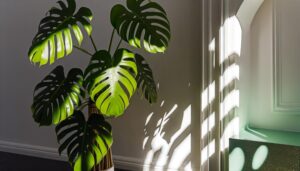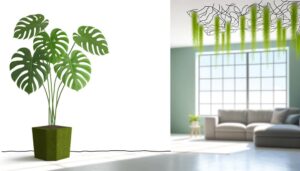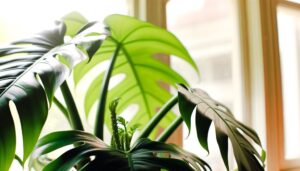Can Monstera Deliciosa Grow in a North Facing Window?
Monstera deliciosa can grow in a north-oriented window, though it may require specific adjustments to its care routine. The scattered light provided by a north-oriented window may not fully meet Monstera’s photosynthetic needs for best growth.
Inadequate light can result in reduced leaf size, leggy growth, and stunted development. Supplementing with artificial grow lights that emit a balanced spectrum of blue and red light can improve photosynthesis.
Monitoring for signs of chlorosis or necrosis is vital. Proper watering and maintaining humidity levels between 60-80% will support its health.
Understanding these conditions could greatly enhance your Monstera’s thriving potential.
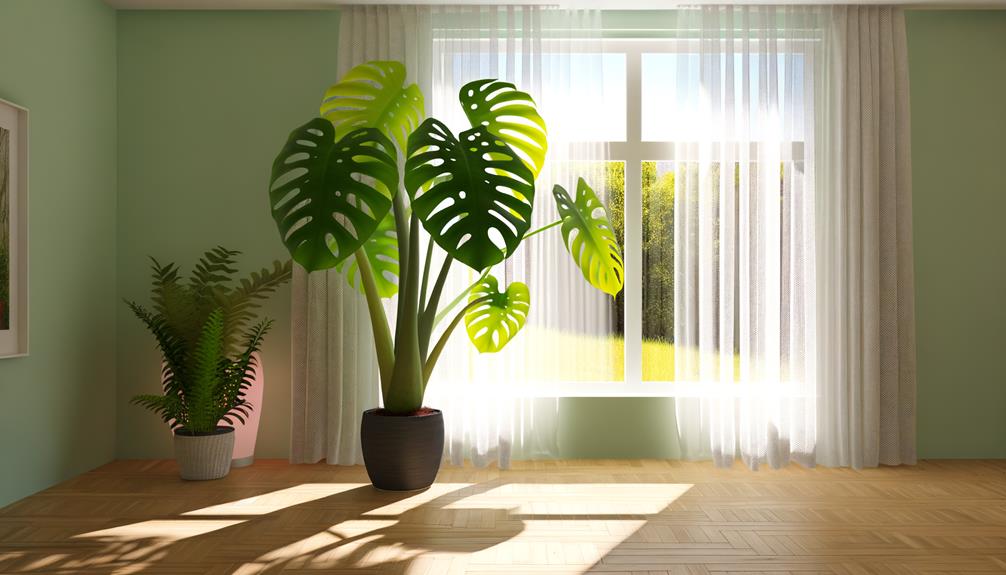
Key Takeaways
- Monstera deliciosa can survive in north-facing windows with moderate, indirect light conditions.
- Growth may be slower with smaller leaves due to limited light intensity.
- Supplemental grow lights can enhance light exposure and promote healthier growth.
- Regularly monitor for signs of light deficiency such as leggy growth or yellowing leaves.
- Ensure proper watering and humidity to support Monstera’s health in suboptimal light conditions.
Understanding North-Facing Windows
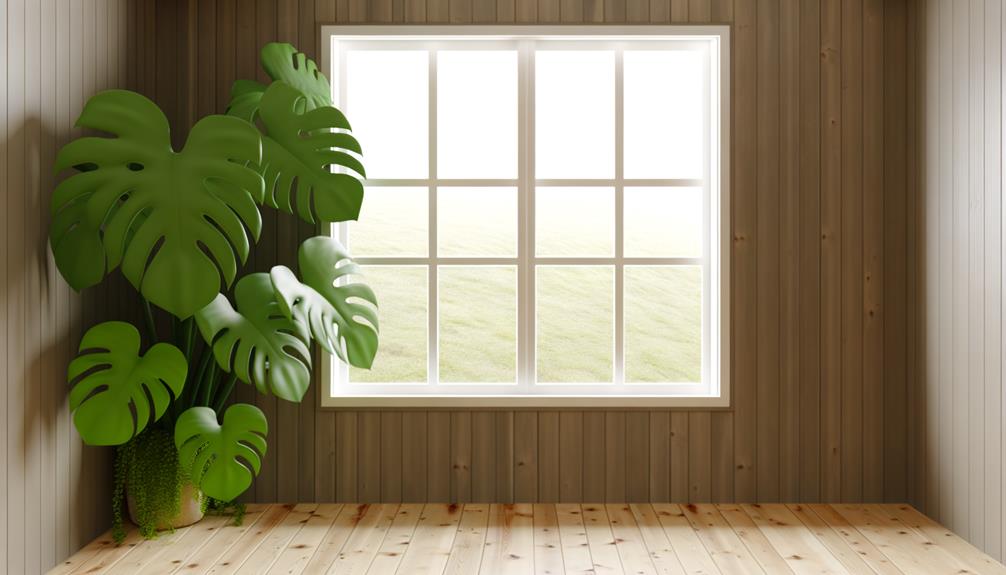
North-oriented windows create a unique microenvironment that significantly influences plant physiology and growth dynamics. These windows receive oblique light throughout the day, providing a consistent but lower light intensity.
The light mainly consists of diffuse light with minimal direct sunlight, affecting photosynthesis rates, stomatal behavior, and chlorophyll production. Understanding these dynamics is crucial for optimizing the placement of various plant species.
The specific light conditions near north-oriented windows favor shade-tolerant plants, mitigating the risk of photoinhibition and leaf scorch. Furthermore, the relatively stable temperature and humidity levels in this area contribute to a more controlled microclimate. This controlled environment can be beneficial for maintaining specific physiological processes in plants.
Monstera Deliciosa Light Needs
Monstera deliciosa is inherently a tropical understory plant that thrives in bright, indirect light, mimicking the dappled sunlight of its native habitat.
However, its adaptability allows it to maintain physiological functions under the lower light conditions typical of a north-facing window.
This adaptability is facilitated by its large, fenestrated leaves, which maximize light capture and photosynthetic efficiency even in suboptimal lighting.
Ideal Light Conditions
Ideal light conditions for Monstera deliciosa involve bright, indirect sunlight, which is essential for its photosynthetic efficiency and overall health. This tropical species thrives under filtered light, mimicking the dappled sunlight of its native rainforest canopy.
Direct sunlight can lead to photoinhibition, causing leaf burn and chlorophyll degradation. Conversely, insufficient light reduces photosynthetic rates, impairing growth and leading to etiolation. The chloroplasts within the Monstera’s cells optimize light absorption under these conditions, promoting robust foliar development and fenestration.
Light intensity, measured in foot-candles or lux, should ideally range between 1000-2500 lux. Moreover, the spectral quality of light, particularly the red and blue wavelengths, is critical for the activation of photosystem II, driving the Calvin cycle and subsequent carbohydrate synthesis.
North Window Adaptability
How does a north-facing window impact the light sufficiency for Monstera deliciosa, given that such windows typically offer lower light levels that may challenge the plant’s photosynthetic efficacy?
Monstera deliciosa, a species adapted to dappled light under forest canopies, requires moderate, indirect light for best growth.
North-facing windows receive limited direct sunlight, leading to reduced light intensity. This suboptimal light condition can impede the plant’s photosynthetic rate, essential for energy production and growth.
Photon flux density (PFD) in north-facing windows often falls below the 100-200 µmol/m²/s range ideal for Monstera.
To mitigate light insufficiency, supplemental artificial lighting, such as full-spectrum LED grow lights, can be employed to optimize photosynthetically active radiation (PAR) for healthy foliage development and overall well-being.
Potential Growth Challenges
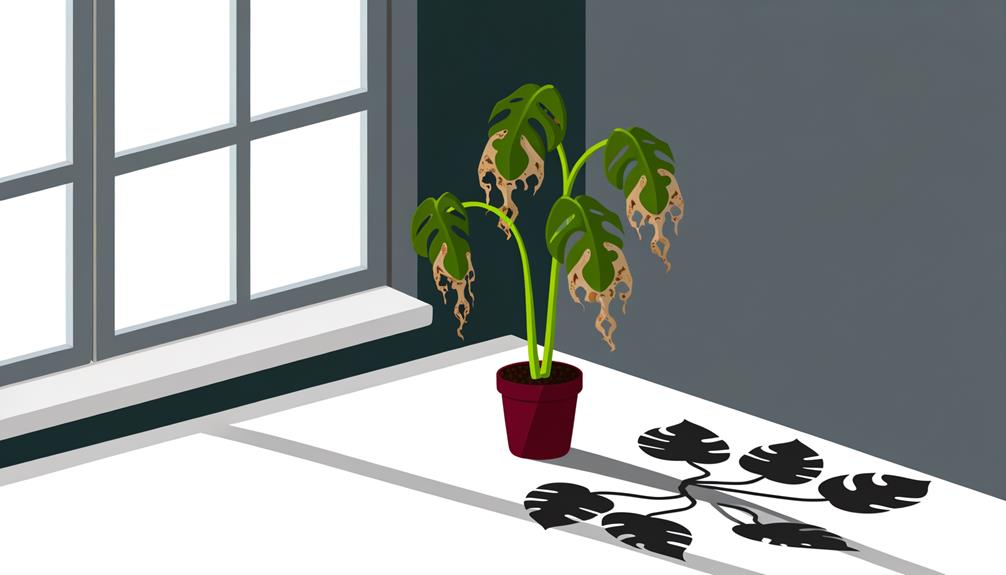
One of the primary growth challenges for Monstera deliciosa placed in a north-facing window is the suboptimal light intensity, which can impede photosynthetic efficiency. Inadequate light exposure can manifest in several physiological and morphological issues, affecting the plant’s overall vitality.
Key challenges include:
- Reduced Leaf Size: Insufficient light can result in smaller, less fenestrated leaves, diminishing the plant’s ornamental value.
- Leggy Growth: Etiolation, characterized by elongated, weak stems, occurs as the plant stretches towards available light sources.
- Stunted Growth: Limited light availability can slow down the metabolic processes, resulting in overall reduced growth rates.
Understanding these challenges is essential for plant enthusiasts aiming to optimize the growth conditions of Monstera deliciosa in low-light environments.
Assessing Natural Light Levels
To mitigate the growth challenges posed by less than ideal light intensity, accurately evaluating the natural light levels in a north-facing window is essential for ensuring the best health and development of Monstera deliciosa. Light levels can be measured in foot-candles (fc) using a light meter. Best growth occurs at 200-500 fc. North-facing windows typically provide lower light intensity, often requiring regular assessments.
| Metric | North-Facing Window |
|---|---|
| Light Intensity (fc) | 50-200 |
| Duration (hours) | 4-6 |
| Quality | Indirect, diffused |
| Peak Hours | Early morning |
Understanding these parameters assists in determining whether additional interventions are necessary to maintain the physiological health and photosynthetic efficiency of Monstera deliciosa.
Supplementing With Artificial Light

To compensate for insufficient natural light in a north-facing window, it is crucial to factor in the ideal light spectrum that promotes photosynthesis in Monstera Deliciosa.
Proper light placement guarantees even distribution and prevents photoinhibition.
Selecting suitable LED bulbs, which provide energy efficiency and customizable spectral outputs, can effectively supplement the plant’s light requirements.
Ideal Light Spectrum
Understanding the best light spectrum for Monstera Deliciosa involves recognizing the plant’s specific photosynthetic needs and how artificial lighting can effectively supplement natural light in a north-facing window.
Monstera Deliciosa thrives under light conditions that closely mimic natural sunlight, particularly within the blue (400-500 nm) and red (600-700 nm) wavelengths. These spectra are critical for chlorophyll absorption and subsequent photosynthetic efficiency.
To ensure peak growth, consider the following artificial lighting solutions:
- Full-Spectrum LED Grow Lights: Emit a balanced spectrum similar to natural sunlight.
- Compact Fluorescent Lights (CFLs): Provide an adequate range of blue and red light.
- High-Pressure Sodium (HPS) Lamps: Effective in delivering red wavelengths, essential for flowering and fruiting stages.
Light Placement Tips
Proper positioning of artificial light sources is crucial for maximizing the photosynthetic efficiency of Monstera Deliciosa in a north-facing window. Placing light fixtures at ideal heights and angles can greatly enhance light absorption.
For example, lights should be positioned 12-18 inches above the plant to replicate natural sunlight angles. Additionally, adjusting light intensity and duration ensures the plant receives sufficient photoperiod exposure without causing light inhibition.
| Light Source Placement | Recommended Distance |
|---|---|
| Overhead | 12-18 inches |
| Side-mounted | 6-12 inches |
| Adjustable arm | 12-20 inches |
Maintaining these distances reduces the chance of leaf burn and supports uniform light distribution across the plant’s foliage, promoting vigorous growth and optimal physiological performance.
Choosing LED Bulbs
When selecting LED bulbs for enhancing natural light in a north-facing window, consider the spectral output and efficiency of the bulbs to maximize photosynthetic activity for Monstera Deliciosa.
LED bulbs with a full-spectrum range closely mimic natural sunlight, supporting chlorophyll production and overall plant health. It is essential to focus on the Photosynthetically Active Radiation (PAR) range, specifically wavelengths between 400-700 nm.
Key considerations include:
- Spectral Quality: Ensure the bulb offers a balanced spectrum, including blue (450-495 nm) and red (620-750 nm) light.
- Energy Efficiency: Opt for bulbs with high lumens per watt to ensure energy is effectively converted into usable light.
- Heat Emission: Select LEDs with low heat output to prevent leaf scorch and promote optimal growth conditions.
Choosing the Right Spot
Selecting an ideal spot for Monstera Deliciosa involves evaluating the light intensity and duration available, especially in a north-facing window which typically receives indirect sunlight. Monstera Deliciosa thrives in bright, indirect light conditions, as excessive direct sunlight can cause leaf scorching and photoinhibition.
North-facing windows provide consistent but lower light levels, which can be supplemented with artificial lighting if natural light proves inadequate. Positioning the plant near the window can optimize photosynthetic efficiency, essential for chlorophyll production and overall growth.
Additionally, consider ambient temperature and humidity, as Monstera prefers 18-30°C and a humidity level of 60-80%. Proper placement guarantees the plant’s physiological needs are met, fostering healthy development and minimizing stress-induced anomalies.
Monitoring Plant Health
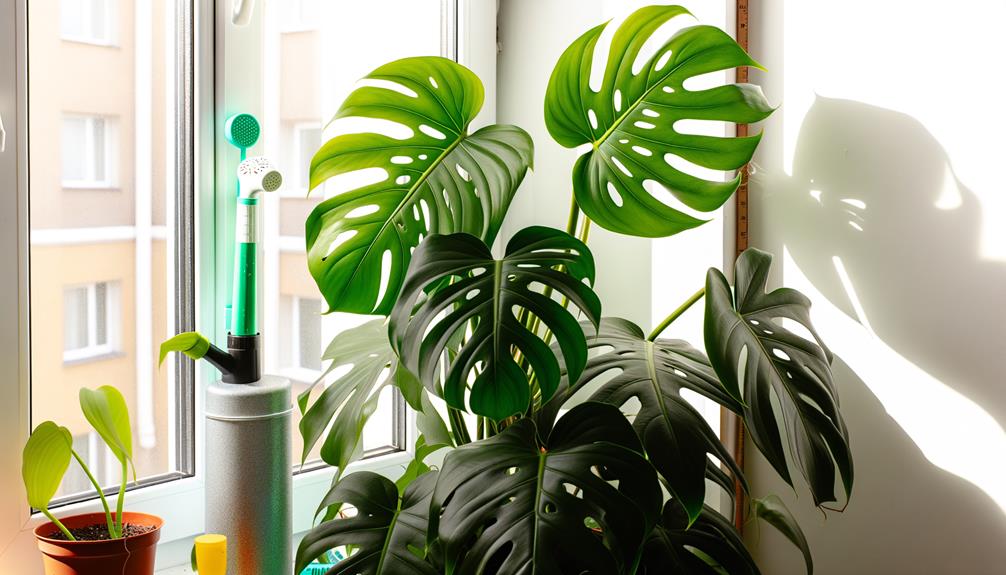
Regularly evaluating the Monstera Deliciosa for signs of physiological stress, such as chlorosis, necrosis, or stunted growth, is crucial to maintaining its health in a north-facing window environment.
Ensuring prime plant health requires close observation of various physiological indicators, which can signal imbalances in environmental conditions.
- Chlorosis: Yellowing of leaves often indicates nutrient deficiencies or inadequate light exposure.
- Necrosis: Brown, dead patches on leaves suggest potential issues with watering practices or pathogen presence.
- Stunted Growth: Limited development may result from insufficient light, improper soil pH, or restricted root space.
Adjusting Care Routine
To enhance the Monstera Deliciosa’s growth in a north-facing window, one must methodically adjust the care routine based on the plant’s specific physiological responses and environmental conditions. This involves regulating watering frequency to prevent root rot, as lower light reduces transpiration rates. Utilize a well-draining soil mix to maintain aeration.
Fertilization should be controlled, given the reduced photosynthetic activity in lower light conditions—using a diluted, balanced fertilizer monthly during active growth periods. Additionally, rotating the plant periodically ensures even light distribution, preventing etiolation.
Humidity levels should be maintained between 60-70%, as Monstera Deliciosa thrives in high-humidity environments. Employing a hygrometer can help monitor and adjust humidity accurately. These adjustments are essential for sustaining peak plant health and growth.
Signs of Light Deficiency
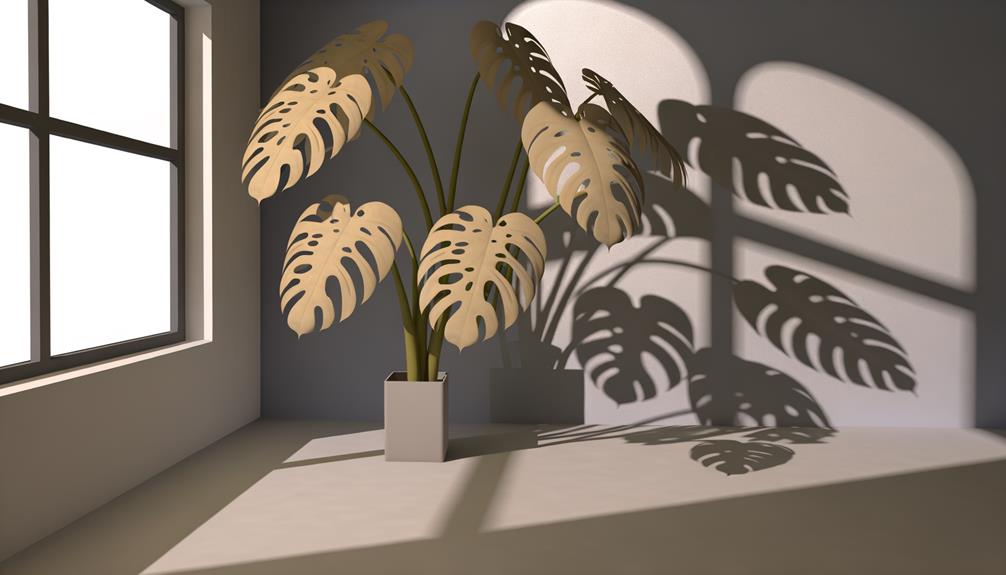
Inadequate light for Monstera Deliciosa often manifests through specific physiological symptoms such as elongated, spindly stems and smaller, paler leaves. These symptoms are indicative of the plant’s attempt to maximize light absorption, a process known as etiolation.
The absence of sufficient light can impair chlorophyll production, resulting in leaves that are less vibrant and more susceptible to damage.
Key indicators of light deficiency include:
- Leggy Growth: Stems elongate and become weak as the plant stretches towards available light.
- Reduced Leaf Size: Leaves grow smaller with fewer fenestrations, compromising the plant’s iconic appearance.
- Yellowing Leaves: Chlorosis occurs due to inadequate photosynthesis, leading to a loss of green pigmentation.
Understanding these signs is essential for diagnosing and addressing light deficiency effectively.
Encouraging Optimal Growth
To achieve best growth for Monstera deliciosa placed in a north-facing window, it is essential to address its light requirements, ensuring it receives indirect but sufficient illumination to support photosynthesis.
Implementing an appropriate watering schedule that maintains soil moisture without promoting root rot is necessary.
Additionally, maintaining humidity levels around 60% will mimic its native tropical environment, fostering strong development and leaf health.
Light Requirements
While Monstera Deliciosa can tolerate lower light conditions, ideal growth is achieved when the plant receives bright, indirect sunlight, mimicking its natural tropical habitat. This light requirement is essential for the plant’s photosynthesis process, which drives energy production and overall health. In a north-facing window, light levels may be suboptimal, potentially hindering growth.
To optimize light conditions, consider the following:
- Supplemental Lighting: Use grow lights to provide additional light, especially during darker months.
- Light Reflectors: Position reflective surfaces around the plant to maximize light exposure.
- Proximity to Window: Place the plant as close to the window as possible to capture maximum available light.
Ensuring adequate light promotes robust growth, vibrant foliage, and the characteristic fenestrations in Monstera Deliciosa.
Watering Schedule
A best watering schedule for Monstera Deliciosa involves maintaining a balance between hydration and aeration to prevent root rot and guarantee nutrient uptake. Monstera Deliciosa prefers soil that remains consistently moist but not waterlogged.
Watering should occur when the top 1-2 inches of soil feel dry to the touch, typically every 1-2 weeks depending on ambient conditions. Utilizing a well-draining potting mix with components such as perlite or orchid bark can enhance aeration.
Overwatering can lead to hypoxic conditions, impairing root respiration and promoting pathogenic infections. Conversely, underwatering may cause cellular dehydration, inhibiting physiological processes like photosynthesis and nutrient transport.
Monitoring soil moisture and adjusting the frequency accordingly is fundamental for ideal plant health.
Humidity Levels
Maintaining high humidity levels, ideally between 60-80%, is crucial for ideal growth of Monstera Deliciosa, as it mimics the plant’s native tropical environment and supports essential physiological processes such as transpiration and nutrient absorption.
Elevated humidity levels facilitate stomatal function, aiding gas exchange and efficient photosynthesis.
To achieve best humidity, consider the following methods:
- Humidifiers: Utilizing a room humidifier can maintain consistent moisture levels, especially during dry seasons.
- Misting: Regularly misting the foliage can temporarily boost humidity around the plant.
- Pebble Trays: Placing the pot on a tray filled with water and pebbles can create a micro-humid environment through evaporation.
Monstera Deliciosa West Facing Window
Monstera deliciosa can thrive in a west-facing window, but there are a few considerations to keep in mind:
- Light Intensity: West-facing windows receive bright, direct sunlight in the afternoon, which can be intense. Monstera deliciosa prefers bright, indirect light, so it’s best to place the plant a few feet away from the window or use sheer curtains to diffuse the light.
- Seasonal Changes: The intensity of light from a west-facing window varies throughout the year. In winter, the light may be ideal for Monstera deliciosa, while in summer, it can be too intense. Monitor your plant and adjust its placement as needed.
- Signs of Too Much Light: If your Monstera is receiving too much direct sunlight, you may notice yellowing or burnt leaves, especially on newer foliage. If this occurs, move the plant further away from the window or provide more shade.
- Signs of Insufficient Light: If your Monstera isn’t receiving enough light, it may exhibit slower growth, smaller leaves, and fewer fenestrations (holes). Ensure your plant is close enough to the window to receive adequate bright, indirect light.
- Humidity and Watering: Monstera deliciosa plants in brighter environments may require more frequent watering and higher humidity levels to maintain healthy growth. Monitor soil moisture and provide humidity through misting, pebble trays, or a humidifier.
In summary, a west-facing window can be suitable for Monstera deliciosa growth, but it’s crucial to monitor light intensity, adjust placement as needed, and provide the right balance of humidity and watering. With proper care, your Monstera can thrive in this environment.
Conclusion
The Monstera deliciosa, similar to a ship sailing through challenging waters, can indeed thrive in a north-facing window, albeit with potential obstacles.
Essential to its journey is the understanding of its photobiological requirements and strategic supplementation of artificial light when natural sources falter.
Regular assessment of its physiological responses and adaptive care routines guarantee the plant’s health and vigor, thereby enabling it to flourish despite less than ideal light conditions.
This balance of light and care epitomizes ideal plant husbandry.


